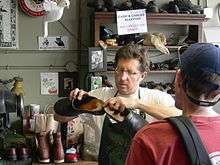Craft
A craft or trade is a pastime or a profession that requires particular skills and knowledge of skilled work. In a historical sense, particularly the Middle Ages and earlier, the term is usually applied to people occupied in small-scale production of goods, or their maintenance, for example by tinkers. The traditional term craftsman is nowadays often replaced by artisan and rarely by craftsperson (craftspeople).
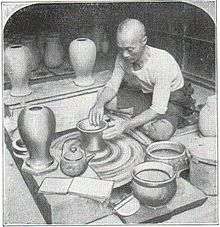
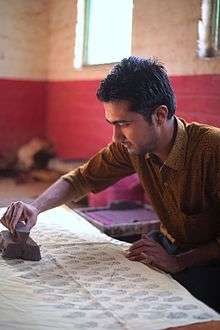
Historically, the more specialized crafts with high value products tended to concentrate in urban centers and formed guilds. The skill required by their professions and the need to be permanently involved in the exchange of goods often demanded a generally higher level of education, and craftsmen were usually in a more privileged position than the peasantry in societal hierarchy. The households of craftsmen were not as self-sufficient as those of people engaged in agricultural work and therefore had to rely on the exchange of goods. Some crafts, especially in areas such as pottery, woodworking, and the various stages of textile production, could be practiced on a part-time basis by those also working in agriculture, and often formed part of village life.
Once an apprentice of a craft had finished his apprenticeship, he would become a journeyman searching for a place to set up his own shop and make a living. After he set up his own shop, he could then call himself a master of his craft.
This system of a stepwise approach to mastery of a craft, which includes the obtainment of a certain amount of education and the learning of skills, has survived in some countries of the world until today. But crafts have undergone deep structural changes since and during the era of the Industrial Revolution. The mass production of goods by large-scale industry has limited crafts to market segments in which industry's modes of functioning or its mass-produced goods would not or cannot satisfy the preferences of potential buyers. Moreover, as an outcome of these changes, craftspeople today increasingly make use of semi-finished components or materials and adapt these to their customers' requirements or demands and, if necessary, to the environments of their customers. Thus, they participate in a certain division of labour between industry and craft.
Classification
There are three aspects to human creativity - Art, Crafts, and Science. Roughly determined, art relies upon intuitive sensing, vision and expression, crafts upon sophisticated technique and science upon knowledge.
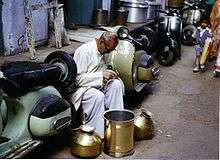
Handicraft
Handicraft is the "traditional" main sector of the crafts, it is a type of work where useful and decorative devices are made completely by hand or by using only simple tools. Usually the term is applied to traditional means of making goods. The individual artisanship of the items is a paramount criterion, such items often have cultural and/or religious significance. Items made by mass production or machines are not handicraft goods. Handicraft goods are made with craft production processes.
The beginning of crafts in areas like the Ottoman Empire involved the governing bodies requiring members of the city who were skilled at creating goods to open shops in the center of town. These people slowly stopped acting as subsistence farmers (who created goods in their own homes to trade with neighbors) and began to represent what we think of a "craftsman" today.[1]
In recent years, crafts and craftspeople have slowly been gaining momentum as a subject of academic study. Stephanie Bunn was an artist before she became an anthropologist, and she went on to develop an academic interest on the process of craft - arguing that what happens to an object before it becomes a 'product' is an area worthy of study. [2]
The Arts and Crafts Movement
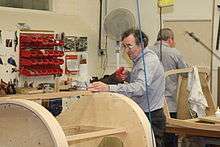
The term crafts is often used to describe the family of artistic practices within the family decorative arts that traditionally are defined by their relationship to functional or utilitarian products (such as sculptural forms in the vessel tradition) or by their use of such natural media as wood, clay, ceramics, glass, textiles, and metal.
Studio crafts
Crafts practiced by independent artists working alone or in small groups are often referred to as studio craft. Studio craft includes studio pottery, metal work, weaving, wood turning, paper and other forms of wood working, glass blowing, and glass art.
Craft fairs
A craft fair is an organized event to display and sell crafts. There are craft shops where such goods are sold and craft communities, such as Craftster, where expertise is shared.
Tradesperson
A tradesperson is a skilled manual worker in a particular trade or craft. Economically and socially, a tradesperson's status is considered between a laborer and a professional, with a high degree of both practical and theoretical knowledge of their trade. In cultures where professional careers are highly prized, there can be a shortage of skilled manual workers, leading to lucrative niche markets in the trades.
See also
|
Communities
|
References
- Suraiya., Faroqhi (2014-01-01). Artisans of Empire : Crafts and Craftspeople Under the Ottomans. I.B. Tauris. p. 119. ISBN 9780857710628. OCLC 956646181.
- Ingold, Tim (2011). Redrawing Anthropology: Materials, Movements, Lines. Farnham: Ashgate Publishing Limited. pp. 21–22.
External links
| Look up craft in Wiktionary, the free dictionary. |
![]()
